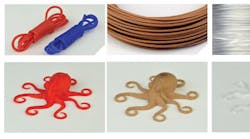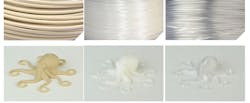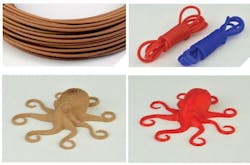The 3D printing industry has no signs of slowing down and the variety of materials that can be used is only increasing. As Bill Wong previously discussed on Electronic Design, 3D printing has become especially useful when it comes to manufacturing cheap prototypes in a timely fashion (see Tap New Technologies To Produce Practically Perfect Prototypes). LulzBot recently announced an assortment of new materials for desktop 3D printers that can aid in on-demand creation.
LulzBot’s latest portfolio additions include everything from traditional thermoplastics to recycled wood fibers. Laybrick is a mineral-based filament that prints similar to polyactic acid (PLA); one of the most common 3D printing material. It can have a smooth or rough finish based on the extrusion temperature (185-215°C) and is deal for architectural models because of it’s near-zero warping.
Taulman’s 645 Nylon is specifically engineered for 3D printing and can be colored with most common clothing dyes. It boasts better surface bonding and is tear resistant. It is also chemically resistant to alcohols, resins+MEK, oils, acetones, most alkalines, and most two-part casting compounds.
T-Glase is a high-strength polyethylene terephthalate polymer (PETT) that is comparable to the material used to make plastic bottles. It is clear and flexible, ideal for printing large, flat surfaces, and has better bridging capabilities. It is a more physically flexible alternative to translucent PLAs for LED covers and other lighting solutions. It is also 100% reclaimable with very little shrinking.
Laywoo-D3 is a mix of recycled wood fibers and polymer binders that is paintable, grindable, carvable, and stainable. It prints similar to PLA and can be printed on a non-heated bed with very little warp. The material even gives off a traditional “wood” smell when printing.
Ninjaflex, also known as thermoplastic urethane (TPU), is LulzBot’s stretchiest offering. The material combines strength, low-temperature performance, abrasion resistance, as well as the aforementioned flexibility. This makes it optimal for cushioning and shock absorption and is commonly used to make wheels, belts, gaskets, and inflatable products. Printing is difficult with a standard extruder because of the flexibility, so a Flexystruder—a Greg’s Wade-style extruder that fully constrains the filament—is recommended.
Watch the video below to see the Ninjaflex and Flexystruder in action:


